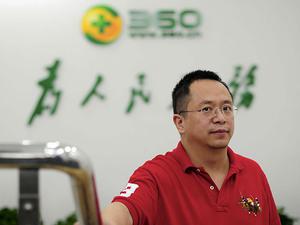感知中国经济的真实温度,见证逐梦时代的前行脚步。谁能代表2019年度商业最强驱动力?点击投票,评选你心中的“2019十大经济年度人物”。【我要投票】
原标题:Reata Pharmaceuticals: Confusion On The Secondary EndpointREATA制药:关于次要终点的困惑 来源:seekingalpha
Summary
Bardoxolone took another large step towards being approved for Alport Syndrome.
Some data regarding the secondary endpoint was misunderstood by the market, leading to the stock actually being punished.
This article shows why this data isn't relevant to accessing Bardoxolone's efficacy or likelihood of being approved.

Yesterday, Reata Pharmaceuticals (RETA) reported the first topline results from its CARDINAL Phase 3 Bardoxolone trial. This is a trial for the use of Bardoxolone on Alport Syndrome. Alport is one of many genetic and environmental conditions leading to ESRD (End-Stage Renal Disease) requiring dialysis or kidney transplantation. Dialysis is typically the largest single cost health systems face.
The results were very positive. Bardoxolone achieved the primary and secondary endpoints. Most importantly, Bardoxolone did not show increased cardiovascular risk, as it had in the past – in a way that made a previous Phase 3 trial on the drug be stopped early.
Based on these results, it now seems likely that Bardoxolone will be approved by the FDA as a unique treatment which might delay or prevent the progression of Alport Syndrome to ESRD (End-Stage Renal Disease) requiring dialysis. Moreover, Bardoxolone shows the same promise in many other indications leading to ESRD.
This should have been a victory for Reata Pharmaceuticals. Yet, in the after-hours session the stock went down, not up. Of course, that kind of reaction (“sell the news”) can always happen. But it seems that in Reata’s case there was actually a bearish thesis making the rounds and punishing the stock. The following tweet encompasses this thesis:

So What’s The Bearish Thesis Here?
The bearish thesis is that from the CARDINAL Phase 2 trial on Alport Syndrome, to the CARDINAL Phase 3 trial on Alport Syndrome, the secondary endpoint saw visibly less improvement.
This is entirely true. It did. This is so because:In the Phase 2 trial, the retained eGFR benefit was +4.1 mL/min/1.73 m2(p<0.05) over baseline (zero).In the Phase 3 trial, the retained eGFR benefit was -0.96 mL/min/1.73 m2, meaning eGFR had fallen below the baseline.
This was read as “no retained benefit.” But was there really no retained benefit? To understand why this is a fake problem one has to understand why the secondary endpoint of “retained benefit” even exists.The Secondary Endpoint’s Reason Of Being
The “retained eGFR benefit” isn’t actually there to measure if the drug is efficacious or not. Thus, there being or not being an absolute “retained benefit” is irrelevant.
Let me explain why by taking a quote from the earlier Phase 2 trial press release (bold highlight is mine):
About the Retained eGFR Benefit Analysis
FDA has accepted for approval in rare forms of CKD theplacebo-corrected “retained eGFR benefit” after withdrawal of drug. The “on treatment” eGFR improvement is the true clinical benefit to the patient, but FDA requires additional evidence that an intervention may delay kidney failure. Withdrawal of drug after long-term treatment provides evidence that a drug either protected or harmed the kidney during treatment. If retained eGFR is higher than placebo, the drug treatment protected kidney function, and if retained eGFR is lower than placebo, the drug treatment harmed kidney function.A positive retained eGFR benefit provides evidence that drug treatment may delay kidney failure. In April 2018, the FDA approved tolvaptan for ADPKD on a placebo-corrected (but below baseline) retained eGFR benefit of 1.27 mL/min/1.73 m2 (tolvaptan: -2.34, placebo: -3.61; Torres et al NEJM 2017).
So what’s the purpose of this analysis? The purpose of the analysis is to see if the drug (bardoxolone or other) isn’t leading to something like ultrafiltration, which improves near-term eGFR at the cost of damaging the kidneys. So the drug is removed for a long period (4 weeks) to see where kidney function actually is (without the drug).
If kidney function (as measured by eGFR) is above the kidney function on the placebo group (which is in constant decline), then the drug did not harm the kidneys, and the effectswhen taking the drugare actually beneficial.
Now remember, Bardoxolone did achieve this secondary endpoint with statistical significance:
At Week 52, patients treated with bardoxolone had a statistically significant improvement compared to placebo in mean retained eGFR of 5.14 mL/min/1.73 m2(p=0.0012).
Also remember again.This isn’t a measure of the drug’s efficacy. The patient is not supposed to stop taking the drug (bardoxolone). The drug is only stopped to understand if there was relative kidney damage.
When it comes to actual efficacy, what mattered was the primary endpoint. This endpoint was also achieved. It, too, showed lower benefit than during the Phase 2 trial, but still a large positive benefit even versus baseline, not just placebo:
After 48 weeks of treatment, patients treated with bardoxolone had a statistically significant improvement compared to placebo in mean eGFR of 9.50 mL/min/1.73 m2(p<0.0001). Patients treated with bardoxolone experienced a statistically significant increase from baseline in mean eGFR of 4.72 mL/min/1.73 m2, while patients treated with placebo experienced a statistically significant decline from baseline in mean eGFR of -4.78 mL/min/1.73 m2.
That is, Bardoxolone didn’t just stop the loss of kidney function, it actually improved it from baseline.So What Did Reata Really Report?
Taking into account the explanation above, Reata reported two things:That the drug works and is very efficacious (primary endpoint).That when the drug is withdrawn, there’s definite proof that it did not harm the kidneys (secondary endpoint).
These two facts mean that Bardoxolone is very likely to be approved by the FDA. Indeed, Bardoxolone is likely to see accelerated approval given the lack of alternatives. This very guidance was given to Reata Pharmaceuticals by the FDA:
The FDA has provided the Company with written guidance that, in patients with CKD caused by Alport syndrome, an analysis of retained eGFR demonstrating an improvement versus placebo after one year of bardoxolone treatment may support accelerated approval and an improvement versus placebo after two years of treatment may support full approval.Conclusion
Although the levels of retained eGFR upon drug withdrawal are lower than those seen in the CARDINAL Phase 2 trial, these levels are still high enough to statistically prove Bardoxolone did not harm long-term kidney function. At the same time, the drug showed efficacy including improvement not just versus placebo but also versus baseline.
There’s no doubt that Bardoxolone took another step towards being approved. This approval will happen first for Alport Syndrome, and then for other common causes leading to ESRD, as other trials are completed.
Idea Generator is my subscription service. It's based on a unique philosophy (predicting the predictable) and seeks opportunities wherever they might be found, by taking into account both valuation (deeply undervalued situations) and a favorable thesis.
Idea Generator has beaten the S&P 500 by around 37% since inception (in May 2015). There is a no-risk, free, 14-day trial available for those wanting to check out the service.
Disclosure:I am/we are long RETA.I wrote this article myself, and it expresses my own opinions. I am not receiving compensation for it (other than from Seeking Alpha). I have no business relationship with any company whose stock is mentioned in this article.
发明内容
Bardoxolone朝着被批准治疗Alport综合征又迈出了一大步。
有关次端点的一些数据被市场误解,导致股票实际上受到惩罚。
本文说明了为什么这些数据与评估巴多松龙的疗效或获得批准的可能性无关。

昨天,Reata制药公司(RETA)报道了其第三阶段巴多松龙试验的第一个TOPLINE结果。这是一项使用巴多松龙治疗Alport综合征的试验。Alport是导致ESRD(终末期肾病)需要透析或肾移植的许多遗传和环境条件之一。透析通常是卫生系统面临的最大单一成本。
结果非常积极。巴多松龙达到了主要和次要终点。最重要的是,巴多龙并没有像过去那样表现出心血管风险的增加--在某种程度上使之前对该药物的第三期试验提前停止。
基于这些结果,现在看来巴多索龙很可能会被FDA批准为一种独特的治疗方法,它可能延缓或阻止Alport综合征向需要透析的ESRD(终末期肾脏疾病)的进展。此外,巴多松龙在导致ESRD的许多其他适应症中也显示出同样的前景。
这本应是Reata制药公司的胜利。然而,在盘后交易时段,股价下跌,而不是上涨。当然,这种反应(“卖新闻”)总是会发生的。但看起来在Reata的案例中,实际上有一个看跌的论断在流传并惩罚股票。下面的推文包含了这篇论文:

那么看跌的论点是什么呢?
看跌的论点是,从Alport综合征的Cardinal 2期试验,到Alport综合征的Cardinal 3期试验,次要终点的改善明显较少。
这是完全正确的。确实发生了。这是因为:在第二阶段试验中,保留的EGFR效益为+4.1mL/min/1.73 m2(p
这被解读为“没有保留的利益”。但是否真的没有保留利益呢?要理解为什么这是一个假问题,人们必须理解为什么“保留收益”的次端点甚至存在。
“保留的EGFR益处”实际上并不是用来衡量药物是否有效的。因此,有没有绝对的“保留利益”是无关紧要的。
让我引用早先的第二阶段试用新闻稿中的一句话来解释原因(粗体突出显示是我的):
关于保留EGFR效益分析
FDA已经接受了罕见形式的CKD的批准,即停药后安慰剂纠正的“保留的EGFR益处”。“治疗中”EGFR的改善对患者来说是真正的临床益处,但FDA需要更多的证据证明干预可以延缓肾功能衰竭。长期治疗后停药提供了药物在治疗过程中保护或损害肾脏的证据。如果保留的EGFR高于安慰剂,药物治疗保护肾功能,如果保留的EGFR低于安慰剂,药物治疗损害肾功能。积极的保留EGFR的益处提供了药物治疗可能延缓肾功能衰竭的证据。2018年4月,FDA批准托伐普坦用于ADPKD,其安慰剂校正后(但低于基线)保留了1.27mL/min/1.73 m2的EGFR益处(托伐普坦:-2.34,安慰剂:-3.61;Torres等人NEJM 2017)。
那么这个分析的目的是什么呢?分析的目的是看看这种药物(巴多松龙或其他)是否不会导致类似超滤的东西,这种超滤以损害肾脏为代价来改善近期的EGFR。因此,药物被去除很长一段时间(4周),以了解肾脏功能实际上在哪里(没有药物)。
如果肾功能(通过EGFR测量)高于安慰剂组的肾功能(持续下降),则药物不会损害肾脏,服用药物时的效果实际上是有益的。
现在请记住,巴多松龙确实达到了这个具有统计学意义的次要终点:
在第52周,与安慰剂相比,接受巴多松龙治疗的患者在统计学上有显著改善,平均保留EGFR为5.14mL/分/1.73m2(p=0.0012)。
还要再次记住,这不是药物疗效的衡量标准。病人不应该停止服用药物(巴多松龙)。停药只是为了了解是否有相对的肾脏损伤。
当谈到实际疗效时,重要的是主要终点。这个终点也实现了。与第二阶段试验相比,它也显示出较低的益处,但即使与基线相比,它仍然具有很大的积极益处,而不仅仅是安慰剂:
在48周的治疗后,与安慰剂相比,用巴多松龙治疗的患者的平均EGFR为9.50mL/min/1.73m2,有统计学意义的改善(p
也就是说,巴多松龙不仅停止了肾功能的丧失,而且实际上从基线开始改善了肾功能。那么Reata到底报告了什么呢?
考虑到上面的解释,Reata报告了两件事:药物起作用并且非常有效(主要终点)。当药物停用时,有明确的证据表明它没有损害肾脏(次要终点)。
这两个事实意味着巴多松龙很有可能得到FDA的批准。事实上,鉴于缺乏替代药物,巴多松龙很可能会得到加速批准。美国食品和药物管理局(FDA)向Reata制药公司提供了以下指导:
FDA已经向该公司提供了书面指导,在Alport综合征引起的CKD患者中,对保留的EGFR进行分析,表明治疗一年后与安慰剂相比有所改善,可能支持加速批准,而治疗两年后相对于安慰剂的改善可能支持完全批准。结论
尽管停药时保留的EGFR水平低于红衣主教2期试验中看到的水平,但这些水平仍然足够高,足以从统计学上证明巴多索龙对长期肾功能没有损害。同时,该药物显示出疗效,不仅与安慰剂相比有改善,而且与基线相比也有改善。
毫无疑问,巴多松龙朝着被批准的方向又迈出了一步。随着其他试验的完成,这种批准将首先发生在Alport综合征,然后是导致ESRD的其他常见原因。
Idea Generator是我的订阅服务。它基于一种独特的哲学(预测可预测的),并通过考虑估值(严重低估的情况)和有利的论断,在任何可能找到机会的地方寻找机会。
自成立以来(2015年5月),Idea Generator以约37%的优势击败了标准普尔500指数(S&P500)。对于那些想要检查服务的人来说,有一个无风险的,免费的,14天的试用期。
披露:我是/我们是Long RETA。我自己写了这篇文章,它表达了我自己的观点。我没有得到它的补偿(除了寻求阿尔法)。我与本文中提到股票的任何公司都没有业务关系。
热门推荐
收起
24小时滚动播报最新的财经资讯和视频,更多粉丝福利扫描二维码关注(sinafinance)









